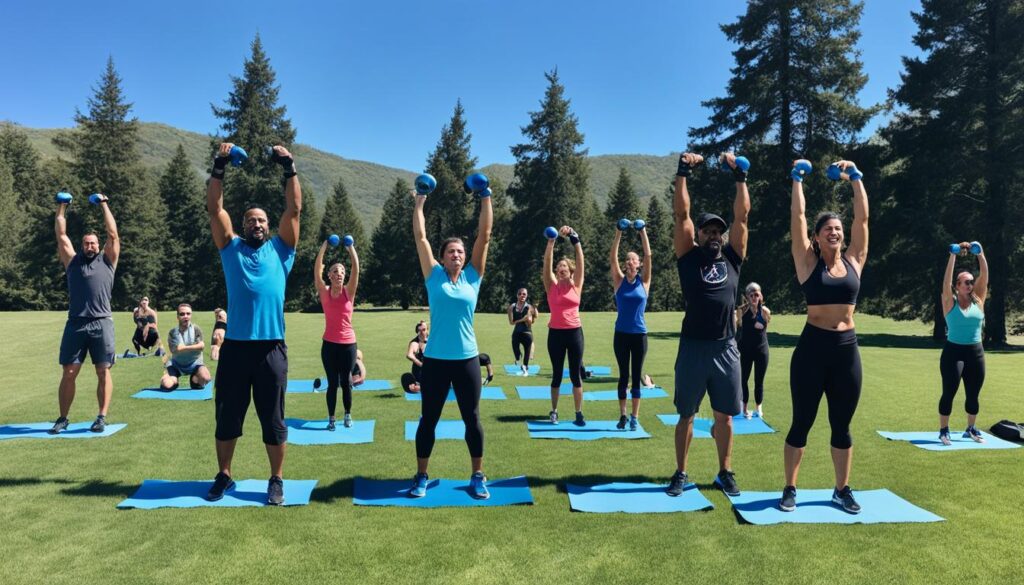Engaging in outdoor cardio activities is a great way to burn fat and elevate your fitness journey. Instead of being confined to the gym, you can take advantage of the fresh air and challenging terrain to maximize your fat-burning potential. In this article, we will explore the top outdoor cardio activities that are effective for burning fat and achieving your weight loss goals.
Key Takeaways
- Outdoor cardio activities are a great way to burn fat and improve fitness
- Taking advantage of the fresh air and challenging terrain can maximize fat-burning potential
- Top outdoor cardio activities include sprints, distance running, cycling, stadium stairs, and boot camp workouts
- Consult with a healthcare professional before starting any new exercise routine
- Consistency and progression are key to achieving weight loss goals through outdoor cardio activities
Sprints for High-Intensity Fat Burning
Sprints are a highly effective form of high-intensity cardio exercise that can help you burn fat and achieve your fitness goals. Incorporating sprints into your outdoor cardio routine can provide numerous benefits, including increased muscular growth and targeting of the posterior-chain muscles such as the glutes and hamstrings.
To structure a sprint workout, begin with a light jog to warm up your muscles and prepare your body for the intense exercise ahead. After the warm-up, perform a series of pre-sprint exercises, such as lunges or leg swings, to further activate your muscles. Once you are properly warmed up, it’s time to start the sprints.
During a sprint workout, alternate between sprinting at your maximum effort and walking or resting during the intervals. This high-intensity workout not only burns calories but also helps increase your muscular strength and explosiveness.
Remember to start with shorter sprint intervals and gradually extend the duration as your fitness level improves. It’s important to listen to your body and avoid overexertion or sprinting on uneven surfaces that could increase the risk of injury.
Benefits of Sprints:
- High-intensity cardio exercise
- Promotes fat burning
- Targets posterior-chain muscles
- Increases muscular growth and strength
- Improves explosiveness and speed
Sample Sprint Workout:
| Exercise | Duration/Repetitions |
|---|---|
| Warm-up Jog | 5 minutes |
| Pre-Sprint Exercises (lunges, leg swings, etc.) | 2 sets of 10 reps |
| Sprint | 20 seconds |
| Rest/Walk | 40 seconds |
| Repeat Sprint/Rest Intervals | 6-8 sets |
| Cool Down | 5-10 minutes of walking |
Sprints are an excellent addition to your outdoor cardio routine, offering a challenging and efficient way to burn fat, increase muscular strength, and improve overall fitness. By incorporating sprints into your workouts, you can take your fat-burning efforts to the next level while enjoying the benefits of outdoor exercise.
Distance Running for Endurance and Fat Loss
Distance running is an excellent outdoor cardio activity that can significantly improve your endurance and contribute to fat loss. By engaging in regular distance running sessions, you challenge your lower body muscles and gradually build stamina. Incorporating running intervals and exercises into your routine can further enhance the benefits of distance running.
To structure a distance running workout, start with a warm-up that includes a combination of walking and jogging. This helps prepare your muscles and gradually elevates your heart rate. Next, incorporate running intervals into your workout. Running intervals involve alternating between periods of higher intensity running and recovery walks. This approach allows you to burn more calories and increase the challenge for your body.
One effective way to structure running intervals is to start with shorter intervals, such as 30 seconds of fast running followed by a 1-minute recovery walk. As you progress, gradually increase the duration and intensity of the running intervals while reducing the recovery time. This progression helps build your stamina and endurance over time.
After completing the running intervals, it’s beneficial to include a post-run strength workout. This can involve exercises such as lunges, squats, and planks to target your lower body muscles and enhance overall strength. Strength training exercises not only contribute to fat loss but also help build lean muscle, which can further increase your metabolism.
Consistency is key when it comes to distance running for fat loss. Aim to incorporate distance running into your weekly routine, gradually increasing your running time and reducing recovery walks. By challenging yourself and progressively pushing your limits, you can progress towards longer-distance runs and achieve your weight loss goals.
Tips for Distance Running:
- Invest in a good pair of running shoes to provide proper support and cushioning for your feet.
- Stay hydrated by drinking water before, during, and after your runs.
- Listen to your body and adjust your running intensity and duration as needed.
- Include sufficient rest and recovery days in your training schedule to prevent overuse injuries.
- Consider incorporating cross-training activities, such as cycling or swimming, to add variety and reduce the risk of overuse injuries.
“Distance running is not just about losing weight or building endurance; it’s a journey that challenges you physically and mentally.”
| Benefits of Distance Running | How It Contributes to Fat Loss |
|---|---|
| Improves cardiovascular health | Elevates heart rate and burns calories |
| Builds endurance and stamina | Increases overall energy expenditure |
| Targets lower body muscles | Promotes lean muscle development |
| Enhances mental well-being | Reduces stress and boosts mood |
Bicycling for Intense Cardiovascular Training

Bicycling is an effective outdoor cardio activity that helps burn calories and improve cardiovascular fitness. Unlike indoor cycling classes, outdoor biking offers the challenge of real hills and requires intense effort to propel the bike forward.
By plotting a route with inclines and incorporating moderate steady-state intensity cycling, uphill sprints, and cooldown cycling, you can optimize the calorie burn and build lean muscle.
Cycling also provides mental well-being benefits and can be tailored to different intensity levels based on your fitness goals.
The Benefits of Outdoor Cycling Workouts
Outdoor cycling workouts offer a wide range of benefits for your physical and mental well-being:
- Calorie-Burning: Outdoor cycling is a highly effective calorie-burning activity that can help you shed excess weight and maintain a healthy body composition.
- Cardiovascular Fitness: By engaging in regular outdoor cycling, you can improve your cardiovascular health, strengthen your heart, and enhance your endurance.
- Lean Muscle Development: Bicycling activates your leg muscles, including the quadriceps, hamstrings, and calves. Regular cycling can help you build lean muscle and achieve a more toned physique.
- Low Impact: Cycling is a low-impact exercise that puts minimal stress on your joints, making it a suitable option for individuals with joint pain or injuries.
- Mental Well-Being: The fresh air, beautiful scenery, and sense of freedom associated with cycling outdoors can boost your mood, reduce stress, and enhance overall mental well-being.
Tips for Effective Outdoor Cycling Workouts
To make the most of your outdoor cycling workouts, follow these tips:
- Choose the Right Bike: Select a bike that suits your riding style and terrain. Whether it’s a road bike, mountain bike, or hybrid bike, ensure it is well-fitted and in good condition.
- Warm Up and Stretch: Prior to your ride, warm up with light aerobic exercise and perform dynamic stretches to prepare your muscles for the exertion.
- Vary Terrain and Intensity: Incorporate hills, flat roads, and different intensity levels into your cycling route to challenge your muscles and cardiovascular system.
- Monitor Heart Rate: Use a heart rate monitor to gauge your exertion level and maintain an appropriate intensity for your fitness goals.
- Stay Hydrated: Carry a water bottle with you and hydrate regularly during your ride, especially on hot days or longer rides.
- Wear Protective Gear: Always wear a helmet, and consider wearing appropriate cycling attire to enhance comfort and safety.
- Invest in Quality Equipment: Make sure your bike is in good working order, and wear proper cycling shoes and gloves to optimize performance and minimize discomfort.
- Cool Down and Stretch: After your ride, cool down with a slower-paced cycling segment, followed by static stretches to improve flexibility and aid recovery.
By incorporating these tips, you can elevate your outdoor cycling workouts and enjoy the numerous benefits this activity has to offer.
Stadium Stairs for Total-Body Fat Burning
Stadium stairs provide an intense workout that targets multiple muscle groups, making it an effective total-body cardio exercise for burning fat. Whether you find a set of stadium stairs or a traditional staircase at a high-rise, this challenging workout will leave you feeling the burn from head to toe.
To structure your stadium stair workout, start with a warm-up consisting of dynamic stretches and mobility exercises to prepare your body for the intense effort ahead. Then, run up and down the stairs in different patterns to engage different muscle groups and keep the workout varied.
When completing your stadium stair workout, focus on maintaining proper form and using your entire body to power through each step. Remember to engage your core and use your arms to assist with momentum.
Finally, cool down with a leisurely walk on a flat surface to gradually lower your heart rate and allow your body to recover. This post-workout cooldown is an essential part of the process and promotes better recovery and muscle growth.
Stadium stairs offer a highly customizable workout that can be modified based on the size and number of stairs available to you. Feel free to experiment with different stair running techniques, such as skipping a step or hopping sideways, to challenge your muscles in new ways.
Not only does a stadium stair workout provide an excellent calorie burn, but it also strengthens your legs, glutes, and core while improving your cardiovascular endurance. Incorporating this total-body cardio exercise into your outdoor routine will help you achieve your weight loss and fitness goals.
Boot Camp for High-Intensity Cardio and Strength Training

Boot camp workouts are a popular choice for those seeking a high-intensity outdoor fitness experience. Combining cardio and strength training exercises, boot camp workouts offer a comprehensive full-body workout that challenges both your cardiovascular endurance and muscular strength.
In a boot camp session, you can expect to engage in high-intensity interval training (HIIT) and circuit training. These workouts typically consist of a series of exercises performed in quick succession, with minimal rest between each exercise.
This intense format not only boosts your heart rate and burns calories but also helps to increase your metabolic rate for ongoing calorie burn even after you’ve finished the workout.
The exercises in a boot camp workout can include a combination of bodyweight exercises, resistance exercises using resistance bands or free weights, and cardio activities such as jumping jacks, burpees, and mountain climbers.
By incorporating loop bands and bodyweight exercises, such as squats, lunges, and planks, boot camp workouts challenge your muscles and elevate your heart rate, creating the perfect environment for fat burning and muscle toning.
Boot camp sessions can be conducted in a group setting led by a qualified instructor or done individually by following a pre-designed routine. Either way, the focus is on pushing your limits and achieving your fitness goals in an outdoor setting.
Benefits of Boot Camp Workouts:
- High-intensity interval training (HIIT) for maximum calorie burn
- Combines cardio and strength training for a comprehensive workout
- Increases muscular strength and endurance
- Improves cardiovascular fitness
- Promotes fat loss and muscle toning
- Offers variety and challenges your body in new ways
- Can be done individually or in a group setting
- Provides motivation and accountability
Boot camp workouts are a great choice for individuals who enjoy pushing themselves to the limit and thrive in a challenging exercise environment. Whether you join a boot camp group or create your own routine, you can experience the benefits of high-intensity cardio and strength training in one dynamic outdoor workout.
Uphill Sprints for Acceleration and Strength

Incorporating uphill sprints into your outdoor cardio routine is an effective way to improve acceleration and strength. By finding hills of varying lengths and slopes, you can target different aspects of your sprinting ability. Smaller hills are ideal for shorter bursts of sprinting, while larger hills challenge your ability to sustain power output.
Starting slow and gradually increasing difficulty and elevation will help you build strength over time. Uphill sprints are a challenging and efficient way to burn fat and enhance your sprinting performance.
Tips for Uphill Sprint Workouts
- Find hills in your local area that have varying degrees of incline.
- Start with a proper warm-up, including dynamic stretches and mobility exercises.
- Begin by sprinting up the hill, focusing on maintaining good form and a strong push-off.
- Take a recovery walk or jog back down the hill.
- Repeat the uphill sprint for a specific number of repetitions or a set time period.
- Gradually increase the intensity and duration of your uphill sprints as you become more conditioned.
Incorporating uphill sprints into your outdoor cardio routine not only helps burn fat but also improves your overall sprinting ability and lower body strength. Make sure to listen to your body, start slow, and consult with a qualified fitness professional if you have any concerns or medical conditions.
| Benefits of Uphill Sprints | How to Perform Uphill Sprints |
|---|---|
|
|
Jogging on the Beach or Boardwalk for Resistance Training

When it comes to outdoor cardio activities, jogging on the beach or boardwalk is a fantastic option that offers both resistance training and a picturesque workout setting. Whether you prefer the feel of sand beneath your feet or the stability of a boardwalk, this activity provides a unique experience that challenges your leg muscles and helps burn fat.
Running on the sand, whether wet or dry, requires extra effort to propel your body forward, engaging additional muscles and increasing energy expenditure. The soft and shifting surface of the sand activates more muscles in your legs, including the calves, quadriceps, hamstrings, and glutes. These muscles work harder to maintain stability and provide the necessary push-off, resulting in a more intense workout compared to running on a flat, solid surface.
Moreover, the resistance provided by the sand helps to strengthen your leg muscles as they have to overcome the sand’s drag and friction with every stride. This added resistance not only enhances muscular endurance but also contributes to creating more lean muscle mass in your lower body.
As with any new exercise, it’s important to start slow and gradually increase your pace when jogging on the beach or boardwalk. The uneven surface and impact on your joints may be different from what you’re accustomed to on a treadmill or pavement, so it’s crucial to listen to your body and adjust accordingly.
Beach jogging offers more than just a challenging workout; it also provides a serene and refreshing environment to unwind and rejuvenate. The sound of crashing waves, the salt-infused breeze, and the stunning ocean view all combine to make your workout a truly immersive and enjoyable experience.
So, the next time you’re looking to spice up your outdoor cardio routine, lace up your running shoes and hit the beach or boardwalk for a resistance training session. Not only will you be burning fat and strengthening your leg muscles, but you’ll also be rejuvenating your mind and spirit in a beautiful natural setting.
Benefits of Jogging on the Beach or Boardwalk:
- Engages additional leg muscles due to the resistance provided by sand
- Strengthens leg muscles
- Increases energy expenditure for enhanced fat burning
- Provides a unique and refreshing outdoor workout experience
- Promotes mental well-being through the calming beach environment
“Jogging on the beach or boardwalk offers a challenging and immersive workout experience that strengthens leg muscles and burns fat effectively.” – Dr. Michelle Carter, Fitness Expert
Resisted Sprints for Speed and Muscle Development

Resisted sprints are a dynamic outdoor cardio exercise that helps improve speed, endurance, and muscle development. Running with a parachute or sled provides resistance, challenging your sprinting form and power output. By incorporating resisted sprint workouts into your routine, you can take your outdoor cardio training to the next level, unlocking new levels of speed and strength.
When performing resisted sprints, it’s important to add resistance gradually and ensure proper form. Running with a parachute or sled requires additional effort and can put strain on your muscles, so it’s crucial to approach these workouts with caution. Start with lighter resistance and gradually increase it as you gain strength and confidence.
Strength training through sprints enables you to target specific muscle groups and build power. The added resistance forces your muscles to work harder, promoting growth and improving overall muscular strength. These workouts stimulate both your fast-twitch and slow-twitch muscle fibers, enhancing your athletic performance and adding variety to your training routine.
Benefits of Resisted Sprints:
- Improve speed and acceleration
- Enhance endurance and stamina
- Promote muscle development and strength
- Diversify your outdoor cardio routine
By incorporating resisted sprints into your outdoor cardio routine, you can challenge yourself in new ways and achieve greater fitness gains. Remember to always listen to your body, warm up properly, and consult with a qualified fitness professional if you have any concerns or questions.
Running with a parachute or sled provides resistance, challenging your sprinting form and power output.
Running Stairs for Cardiovascular Endurance and Strength

Running stairs is a fantastic outdoor cardio activity that not only gets your heart pumping but also helps you build total-body strength. When you find a high set of stairs, you can engage your leg muscles and elevate your heart rate by running up and down repeatedly. This exercise targets your cardiovascular endurance, giving your heart and lungs a challenging workout, while also working your lower body muscles, including your quadriceps, hamstrings, glutes, and calves.
When performing stair running, always prioritize safety and proper form. Be cautious when ascending and descending the stairs to avoid tripping or falling. Maintain an upright posture, engage your core, and lift your knees to ensure proper stride and maximum power output. This will help you optimize your workout and reduce the risk of injuries.
Running stairs provides a dual benefit of cardio and strength training, making it a valuable addition to any outdoor exercise routine. The high intensity of stair running increases your heart rate, helping you burn calories and improve your cardiovascular fitness. Additionally, the repetitive action of climbing stairs strengthens your lower body muscles, enhancing your overall strength and endurance.
To make the most of your stair running workout, consider incorporating different variations and intensities. You can try running up the stairs as fast as possible for an intense burst of cardio or incorporate intervals by alternating between running up and walking or jogging down. These variations will challenge your body in different ways, keeping the workout interesting and effective.
Don’t underestimate the power of running stairs for calorie burn and fat burning. This challenging exercise can help you achieve your fitness goals and make your outdoor workouts more dynamic and engaging. So, the next time you’re looking for an effective and efficient cardio and strength training workout, give running stairs a try!
Are These Outdoor Cardio Activities Effective for Weight Loss?
Looking to shed some extra pounds? Try some of the top cardio workouts for weight loss: running, cycling, and swimming. These outdoor activities are not only effective for improving cardiovascular health but are also great for burning calories and aiding in weight loss. So lace up those running shoes and get moving!
Jump Rope for Rhythmic and Intense Cardio Workout

Jumping rope is a highly effective cardio exercise that offers a fun and intense outdoor workout. By grabbing a jump rope and maintaining a steady rhythm, you can elevate your heart rate and challenge your coordination.
Jumping rope improves motor skills, agility, speed, and power while providing a low-impact workout. It engages various muscle groups, including your legs, core, and arms, making it a full-body exercise. The rhythmic and repetitive nature of jump rope also helps improve cardiovascular endurance.
One of the great advantages of jump rope is its versatility. You can easily incorporate it into your outdoor cardio routine, whether you’re at the park, in your backyard, or even on the beach. It requires minimal equipment, making it a convenient option for on-the-go workouts.
To get the most out of your jump rope workout, you can set a timer for a specific duration, such as 10 or 20 minutes, and perform as many sets as you can within that time frame. If you’re a beginner, start with shorter intervals and gradually increase the duration as your fitness level improves. You can also mix in different jump rope variations, such as high knees, single leg jumps, or double unders, to keep the workout challenging and engaging.
Benefits of Jump Rope:
- Effective calorie burn: Jumping rope at a moderate to high intensity can help you burn a significant amount of calories, contributing to fat loss and weight management.
- Improved cardiovascular fitness: The rhythmic and continuous jumping motion of jump rope elevates your heart rate, strengthening your heart and improving your overall cardiovascular endurance.
- Enhanced coordination and balance: Jump rope requires coordination between your upper and lower body movements, helping improve your motor skills, balance, and agility.
- Low-impact exercise: Unlike high-impact activities like running, jump rope puts less stress on your joints and can be a suitable option for individuals with joint pain or injuries.
- Portable and convenient: Jump rope is a portable exercise option that can be done anywhere, allowing you to stay active and maintain your fitness routine even when you’re away from home or without access to a gym.
Incorporating jump rope into your outdoor cardio routine can be a fun and effective way to burn calories, improve cardiovascular fitness, and challenge yourself physically. Remember to choose a suitable jump rope length, wear comfortable shoes, and start with a warm-up to prepare your body for the workout. Ensure proper form and gradually increase intensity and duration as you progress. Happy jumping!
Conclusion
Outdoor cardio routines provide a wide range of options for individuals looking to burn fat and enhance their overall fitness. Whether you prefer sprints, distance running, cycling, stadium stairs, or boot camp workouts, the key is to choose activities that challenge your body and keep you motivated. By incorporating these effective fat-burning activities into your routine, you can elevate your fitness journey and achieve your weight loss goals.
Outdoor cardio activities offer various benefits beyond burning calories. They allow you to enjoy the fresh air, explore new environments, and benefit from natural terrain. Additionally, outdoor cardio workouts can provide mental and emotional well-being, improving your mood and reducing stress levels.
When embarking on outdoor cardio routines, it is important to remember a few tips for weight loss success. First, consult with a qualified healthcare professional or licensed physical therapist to ensure you’re selecting activities that are suitable for your fitness level and any pre-existing conditions. Second, gradually increase the intensity and duration of your workouts to avoid injury and maximize results. And finally, always prioritize safety by wearing appropriate gear, staying hydrated, and being mindful of your surroundings.
Source Links
- https://www.resultspt.com/blog/posts/enjoyable-outdoor-cardio-workouts
- https://www.oxygenmag.com/workouts-for-women/5-outdoor-workouts-to-burn-fat-and-boost-performance/
- https://www.eatthis.com/best-outdoor-cardio-exercises/




